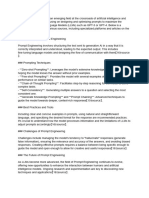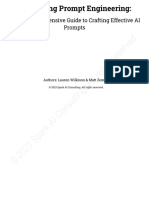Comprehensive Guide to Prompt Engineering
1. Introduction to Prompt Engineering
Prompt engineering is the practice of crafting effective input queries to maximize the quality of
responses from AI models. It involves structuring prompts clearly, setting context, and iterating to
achieve the desired output.
2. Key Concepts in Prompt Engineering
- Zero-shot, Few-shot, and Chain-of-Thought prompting
- Temperature, Top-K, and Top-P sampling techniques
- Context window limitations and how to optimize responses
3. Tools & Technologies Used
- OpenAI API (GPT models)
- Anthropic?s Claude AI
- Google?s Gemini AI
- LangChain and LlamaIndex for advanced AI workflow integrations
4. 100+ Interview Questions & Answers
Q1: What is prompt engineering?
A: It is the art of designing prompts to optimize AI responses by structuring inputs effectively.
Q2: What are the different types of prompting?
A: Zero-shot (no examples), Few-shot (some examples), and Chain-of-Thought (step-by-step
reasoning).
Q3: What factors influence the quality of AI responses?
A: Clarity of prompt, use of structured input, temperature settings, and model training data.
Q4: How can you avoid AI hallucinations?
A: By using clear instructions, context-based prompting, and verifying responses with external data.
Q5: What are the best practices for writing effective prompts?
A: Be specific, provide context, use examples, and iterate for improvement.


























































